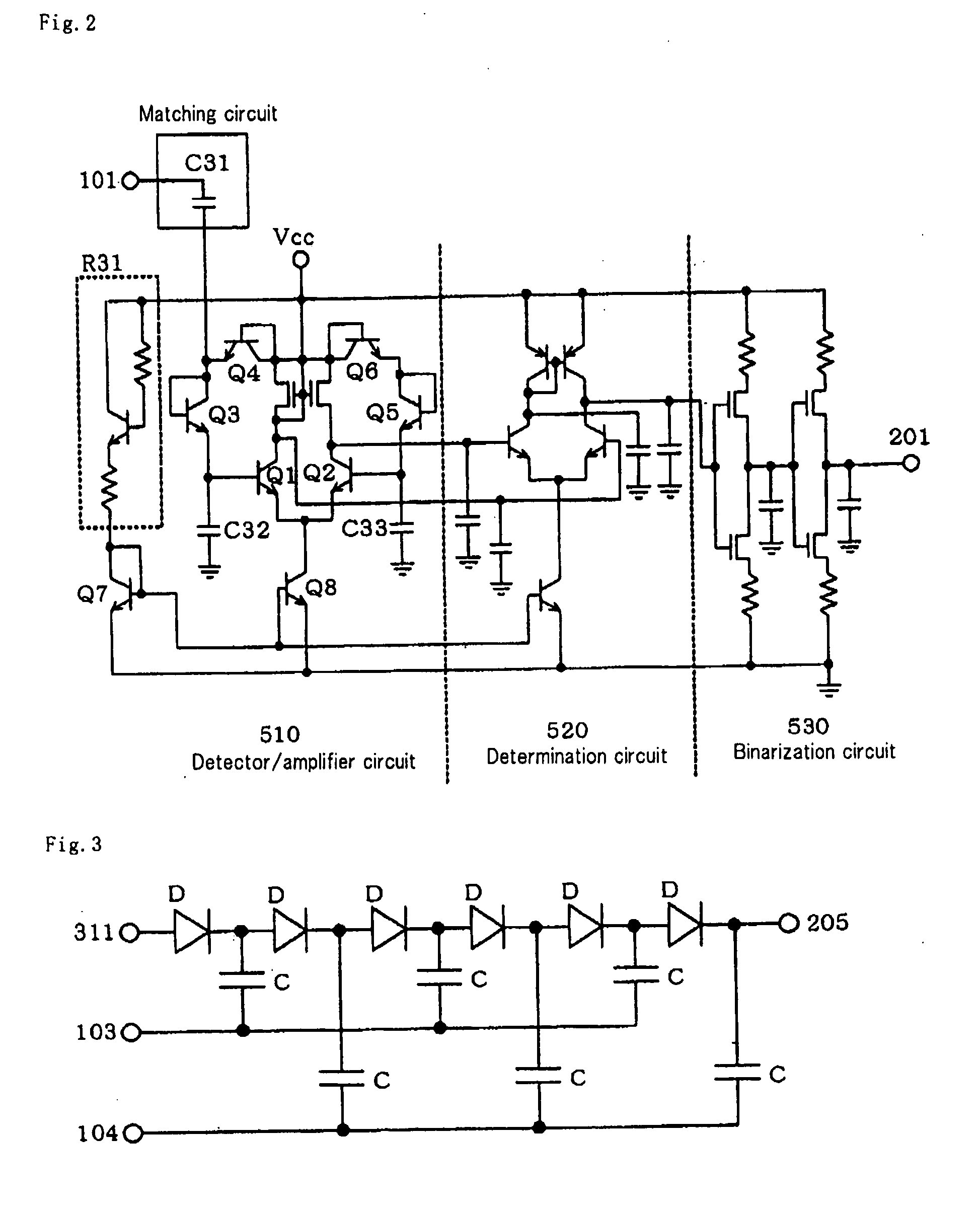Start signal detector circuit
a detector circuit and start signal technology, applied in the direction of electrical control, pulse technique, instruments, etc., can solve the problems of circuit oscillation and significant increase in input capacitance, and achieve the effect of improving the rectification efficiency of the rectifier circuit for detection, stably detecting a start signal, and reducing power consumption of the smart plate system
- Summary
- Abstract
- Description
- Claims
- Application Information
AI Technical Summary
Benefits of technology
Problems solved by technology
Method used
Image
Examples
first exemplary embodiment
[0058]FIG. 6 is a circuit diagram of a start signal detector circuit of a first exemplary embodiment of the present invention, In FIG. 6, 101 designates an RF input terminal; 201 designates an output terminal; 301, 302 designate DC bias terminals; M1, M2 designate MOS transistors; C1, C2 designate capacitors; and R1 designates a resistor. MOS transistor M1 has a drain terminal connected to DC bias terminal 301, and a source terminal connected to RF input terminal 101 through capacitor C1. A DC potential at a gate terminal is supplied from DC bias terminal 302 through resistor R1. Also, MOS transistor M2 has a drain terminal and a gate terminal commonly connected to node N1 and applied with RF signal through capacitor C1. MOS transistor M2 has a source connected to output terminal 201. Also, capacitor C2 for signal charge accumulation is connected to the source of MOS transistor M2.
[0059]In this circuit, a current flows into capacitor C1 from bias terminal 301 through MOS transistor ...
second exemplary embodiment
[0060]FIG. 7 is a circuit diagram of a start signal detector circuit of a second exemplary embodiment of the present invention. In FIG. 7, 101 designates an RF input terminal; 102 designates an RF input terminal which is applied with an RF signal at a phase opposite to 101; 201 designates an output terminal; 301, 302 designate DC bias terminals; M1 , M2 designate MOS transistors; C1-C3 designate capacitors; and R1 designates a resistor. MOS transistor M1 has a drain terminal connected to DC bias terminal 301, and a source terminal and a gate terminal connected to RF input terminals 101, 102, respectively, through capacitor C1, C3. Therefore, the source terminal and gate terminal are applied with RF signals at phases opposite to each other. Also, MOS transistor M2 has a drain terminal and a gate terminal commonly connected to node N1 and applied with an RF signal through capacitor C1. MOS transistor M2 has a source connected to output terminal 201, and capacitor C2 for signal charge ...
third exemplary embodiment
[0062]FIG. 8 is a circuit diagram of a start signal detector circuit of a third exemplary embodiment of the present invention. The circuit of this embodiment comprises series resonance circuits which are added to RF input terminals 101, 102 in the start signal detector circuit of the second exemplary embodiment shown in FIG. 7. Specifically, inductor L1 and capacitor C15 connected to RF input terminal 101 are designed to resonate in series in a desired frequency band, and likewise, inductor L2 and capacitor C16 connected to RF input terminal 102 are designed to resonate in series in a desired frequency band. In this circuit, an impedance viewed from RF input terminals 101, 102 toward the inductor is minimized in the desired frequency band, whereas impedance viewed from nodes N5, N6 toward the inductor is maximized, and the amplitudes of signals at nodes N5, N6 are increased by the resonance, so that the non-linearity of MOS transistor M1 can be further increased. As a result, the re...
PUM
 Login to View More
Login to View More Abstract
Description
Claims
Application Information
 Login to View More
Login to View More - R&D
- Intellectual Property
- Life Sciences
- Materials
- Tech Scout
- Unparalleled Data Quality
- Higher Quality Content
- 60% Fewer Hallucinations
Browse by: Latest US Patents, China's latest patents, Technical Efficacy Thesaurus, Application Domain, Technology Topic, Popular Technical Reports.
© 2025 PatSnap. All rights reserved.Legal|Privacy policy|Modern Slavery Act Transparency Statement|Sitemap|About US| Contact US: help@patsnap.com



